Analysis of Spatial and Temporal Evolution Characteristics and Driving Forces of NDVI in Gansu Province from 2000 to 2022
Abstract
1. Introduction
2. Materials and Methods
2.1. Research Area
2.2. Data Source
2.3. Research Method
2.3.1. Sen + Mann–Kendall Significance Test
2.3.2. Hurst Index
2.3.3. Partial Correlation Analysis
2.3.4. Multiple Residual Regression Analysis
2.3.5. Geographic Detector Model
- (1)
- Factor detection
- (2)
- Interactive detection
3. Results
3.1. The Spatio-Temporal Variation Characteristics of NDVI
3.1.1. The Interannual Variation Characteristics of NDVI
3.1.2. Spatial Variation Characteristics of the NDVI
3.2. The Future Changing Trend of NDVI in Gansu
- (1)
- Sustained Improvement Zone: Covering 193,700 km2 (45.5% of the province), this region is mainly distributed in Jiuquan, Wuwei, Qingyang, and Pingliang. NDVI values here are expected to continue increasing, supporting a sustained improvement in ecological conditions.
- (2)
- Improvement-to-Degradation Transition Zone: Encompassing 219,200 km2 (51.47% of the total area), this category represents the most extensive trend type and is concentrated in central and southeastern Gansu. The NDVI in these regions is likely to reverse from an upward to a downward trend, posing a risk to continued ecological improvement.
- (3)
- Sustained Degradation Zone: Scattered in localized parts of central Jiuquan, central Zhangye, and northern Lanzhou, this zone covers only 3500 km2 (0.83% of the province). NDVI is expected to continue declining, indicating persistent ecological pressure.
- (4)
- Degradation-to-Improvement Transition Zone: Covering 9400 km2 (2.2% of the province), this area can be found mainly in northern Jiuquan and central Wuwei. A future shift from degradation to improvement is anticipated, suggesting potential ecological recovery.
3.3. Analysis of the Driving Forces of NDVI Changes in Gansu Province
3.3.1. Respective Impact Characteristics and Spatial Distribution Patterns of Climate and Human Activities on NDVI
3.3.2. Analysis of the Relative Contribution Rates of Climate Change and Human Activities to NDVI in Gansu Province
4. Discussion
4.1. The Impact of Climate on the Spatiotemporal Variations in NDVI in Gansu Province
4.2. Anthropogenic Impact on Spatiotemporal Variations in NDVI in Gansu Province
4.3. Synergistic Mechanisms of Climate Change and Human Activities on NDVI in Gansu Province
- (1)
- Factor detection
- (2)
- Interaction detection
5. Conclusions
- (1)
- The growing-season NDVI in Gansu Province exhibited a significantly increasing trend overall (0.0029 per year, p < 0.05). Spatially, NDVI showed a distinct pattern of “higher in the southeast and lower in the northwest.” Although low vegetation coverage dominated the entire province, 41.42% of the area experienced an extremely significant increasing trend (p < 0.01).
- (2)
- Future vegetation trends present both opportunities and risks. The area with sustained or potential improvement accounts for 45.5% of the province, while regions facing sustained degradation or a reversal from improvement to degradation account for 54.5%.
- (3)
- Partial correlation analysis revealed that NDVI was positively correlated with precipitation and temperature in most areas, whereas it was negatively correlated with solar radiation. Spatially, 13.86% of the region showed a significant positive correlation with precipitation (p < 0.05), while 11.32% exhibited a significant negative correlation with solar radiation (p < 0.05).
- (4)
- The contribution rate of human activities to NDVI changes surpassed that of climate change. Human activities played a positive role in 88.58% of the province, with nearly half of the area experiencing a contribution rate exceeding 60%. Precipitation was the dominant climatic factor, while solar radiation increasingly influenced vegetation dynamics under global warming.
- (5)
- Interaction detection revealed that two-factor interactions—particularly between precipitation and land use—significantly enhanced the explanatory power of NDVI spatial heterogeneity. Human activities, mediated through land use and population distribution, played a critical regulatory role in vegetation dynamics under precipitation constraints.
Author Contributions
Funding
Data Availability Statement
Conflicts of Interest
References
- Davis, E.; Trant, A.J.; Hermanutz, L.; Whitaker, D.J.S.U. Plant-Environment Interactions in the Low Arctic Torngat Mountains of Labrador. Ecosystems 2021, 24, 1038–1058. [Google Scholar] [CrossRef]
- Wei, X.; Yang, J.; Luo, P.; Lin, L.; Lin, K.; Guan, J. Assessment of the variation and influencing factors of vegetation NPP and carbon sink capacity under different natural conditions. Ecol. Indic. 2022, 138, 108834. [Google Scholar] [CrossRef]
- Wang, Y.; You, C.; Tan, X.; Ren, T.; Su, T.; Han, X.; Chen, S. Co-regulation of climate and vegetation on seasonal and interannual variations of energy exchange over a temperate grassland. Agric. For. Meteorol. 2025, 369, 110556. [Google Scholar] [CrossRef]
- Zhao, J.; Huang, S.; Huang, Q.; Wang, H.; Leng, G.; Peng, J.; Dong, H. Copula-Based Abrupt Variations Detection in the Relationship of Seasonal Vegetation-Climate in the Jing River Basin, China. Remote Sens. 2019, 11, 1628. [Google Scholar] [CrossRef]
- Tuoku, L.; Wu, Z.; Men, B. Impacts of climate factors and human activities on NDVI change in China. Ecol. Inform. 2024, 81, 102555. [Google Scholar] [CrossRef]
- Xie, Y.; Wang, X.; Silander, J.A. Deciduous forest responses to temperature, precipitation, and drought imply complex climate change impacts. Proc. Natl. Acad. Sci. USA 2015, 112, 13585–13590. [Google Scholar] [CrossRef]
- Pu, G.; Han, L.; Chen, L.; Wan, D.; Teng, H. Elevational dynamics of vegetation changes in response to climate change on the Tibetan plateau. Sci. Rep. 2025, 15, 9813. [Google Scholar] [CrossRef] [PubMed]
- Zhou, Y.; Batelaan, O.; Guan, H.; Liu, T.; Duan, L.; Wang, Y.; Li, X. Assessing long-term trends in vegetation cover change in the Xilin River Basin: Potential for monitoring grassland degradation and restoration. J. Environ. Manag. 2024, 349, 119579. [Google Scholar] [CrossRef]
- Farbo, A.; Sarvia, F.; De Petris, S.; Basile, V.; Borgogno-Mondino, E. Forecasting corn NDVI through AI-based approaches using sentinel 2 image time series. ISPRS J. Photogramm. Remote Sens. 2024, 211, 244–261. [Google Scholar] [CrossRef]
- Guo, Y.; Zhang, L.; He, Y.; Cao, S.; Li, H.; Ran, L.; Ding, Y.; Filonchyk, M. LSTM time series NDVI prediction method incorporating climate elements: A case study of Yellow River Basin, China. J. Hydrol. 2024, 629, 130518. [Google Scholar] [CrossRef]
- Wang, J.; Wang, K.; Zhang, M.; Zhang, C. Impacts of Climate Change and Human Activities on Vegetation Cover in Hilly Southern China. Ecol. Eng. 2015, 81, 451–461. [Google Scholar] [CrossRef]
- Liu, S.; Li, W.; Qiao, W.; Wang, Q.; Hu, Y.; Wang, Z. Effect of Natural Conditions and Mining Activities on Vegetation Variations in Arid and Semiarid Mining Regions. Ecol. Indic. 2019, 103, 331–345. [Google Scholar] [CrossRef]
- Shi, S.; Li, W.; Lin, X.; Zhai, Y.; Ding, Y. Spatiotemporal Variations of Vegetation NDVl and Influencing Factors in Heilongjiang Province. Res. Soil Water Conserv. 2023, 30, 294–305. [Google Scholar] [CrossRef]
- Zhang, L.; Cong, Z.; Zhang, D.; Li, Q. Response of Vegetation Dynamics to Climatic Variables across a Precipitation Gradient in the Northeast China Transect. Hydrol. Sci. J. 2017, 62, 1517–1531. [Google Scholar] [CrossRef]
- Zhang, Y.; Zhang, L.; Wang, J.; Dong, G.; Wei, Y. Quantitative Analysis of NDVI Driving Factors Based on the Geographical Detector Model in the Chengdu-Chongqing Region, China. Ecol. Indic. 2023, 155, 110978. [Google Scholar] [CrossRef]
- Liang, Z.; Sun, R.; Duan, Q. Spatiotemporal variation of NDVI in the Yellow River water conservation zone and its driving factors. Prog. Geogr. 2023, 42, 1717–1732. [Google Scholar] [CrossRef]
- Xun, Q.; An, S.; Lu, M. Climate change and topographic differences influence grassland vegetation greening across environmental gradients. Front. Environ. Sci. 2024, 11, 1324742. [Google Scholar] [CrossRef]
- Liu, Y.; Tian, J.; Liu, R.; Ding, L. Influences of climate change and human activities on NDVI changes in China. Remote Sens. 2021, 13, 4326. [Google Scholar] [CrossRef]
- Sun, R.; Chen, S.; Su, H. Climate dynamics of the spatiotemporal changes of vegetation NDVI in northern China from 1982 to 2015. Remote Sens. 2021, 13, 187. [Google Scholar] [CrossRef]
- Kalisa, W.; Igbawua, T.; Henchiri, M.; Ali, S.; Zhang, S.; Bai, Y.; Zhang, J. Assessment of climate impact on vegetation dynamics over East Africa from 1982 to 2015. Sci. Rep. 2019, 9, 16865. [Google Scholar] [CrossRef]
- Yang, X.; Li, X.; Wang, X.; Ding, F.; Chen, F.; Wang, J.; Zhang, X.; Zhang, Y. Meta-analysis of the correlation between vegetation and precipitation in the temperate deserts of the Northern Hemisphere over the last 40 years. Ecol. Indic. 2022, 142, 109269. [Google Scholar] [CrossRef]
- Sharma, M.; Bangotra, P.; Gautam, A.S.; Gautam, S. Sensitivity of normalized difference vegetation index (NDVI) to land surface temperature, soil moisture and precipitation over district Gautam Buddh Nagar, UP, India. Stoch. Environ. Res. Risk Assess. 2022, 36, 1779–1789. [Google Scholar] [CrossRef]
- Liu, L.; Gou, X.; Wang, X.; Yang, M.; Qie, L.; Pang, G.; Wei, S.; Zhang, F.; Li, Y.; Wang, Q.; et al. Relationship between extreme climate and vegetation in arid and semi-arid mountains in China: A case study of the Qilian Mountains. Agric. For. Meteorol. 2024, 348, 109938. [Google Scholar] [CrossRef]
- Li, X.; Wang, Y.; Zhao, Y.; Zhai, J.; Liu, Y.; Han, S.; Liu, K. Research on the impact of climate change and human activities on the NDVI of arid areas—A case study of the Shiyang River Basin. Land 2024, 13, 533. [Google Scholar] [CrossRef]
- Zheng, K.; Tan, L.; Sun, Y.; Wu, Y.; Duan, Z.; Xu, Y.; Gao, C. Impacts of climate change and anthropogenic activities on vegetation change: Evidence from typical areas in China. Ecol. Indic. 2021, 126, 107648. [Google Scholar] [CrossRef]
- Becerril-Pina, R.; Mastachi-Loza, C.A.; Gonzalez-Sosa, E.; Diaz-Delgado, C.; Ba, K.M. Assessing desertification risk in the semi-arid highlands of central Mexico. J. Arid. Environ. 2015, 120, 4–13. [Google Scholar] [CrossRef]
- Evans, J.; Geerken, R. Discrimination between climate and human-induced dryland degradation. J. Arid. Environ. 2004, 57, 535–554. [Google Scholar] [CrossRef]
- Li, P.; Wang, J.; Liu, M.; Xue, Z.; Bagherzadeh, A.; Liu, M. Spatio-temporal variation characteristics of NDVI and its response to climate on the Loess Plateau from 1985 to 2015. CATENA 2021, 203, 105331. [Google Scholar] [CrossRef]
- Mehmood, K.; Anees, S.A.; Rehman, A.; Pan, S.; Tariq, A.; Zubair, M.; Liu, Q.; Rabbi, F.; Khan, K.A.; Luo, M. Exploring spatiotemporal dynamics of NDVI and climate-driven responses in ecosystems: Insights for sustainable management and climate resilience. Ecol. Inform. 2024, 80, 102532. [Google Scholar] [CrossRef]
- Yang, S.; Zhao, Y.; Yang, D.; Lan, A. Analysis of vegetation NDVI changes and driving factors in the Karst concentration distribution area of Asia. Forests 2024, 15, 398. [Google Scholar] [CrossRef]
- Wang, J.F.; Zhang, T.L.; Fu, B.J. A measure of spatial stratified heterogeneity. Ecol. Indic. 2016, 67, 250–256. [Google Scholar] [CrossRef]
- Wang, J.; Xu, C. Geodetector: Principle and prospective. Acta Geogr. Sin. 2017, 72, 116–134. (In Chinese) [Google Scholar]
- Liu, C.; Dong, X.; Liu, Y. Changes of NPP and their relationship to climate factors based on the transformation of different scales in Gansu, China. CATENA 2015, 125, 190–199. [Google Scholar] [CrossRef]
- Jin, K.; Wang, F.; Li, P. Responses of Vegetation Cover to Environmental Change in Large Cities of China. Sustainability 2018, 10, 270. [Google Scholar] [CrossRef]
- Lu, X.; Liang, Y.; Zhao, T.; Zhu, X.; Qin, Z. Decreasing soil erosion in South China with uncertainties driven by NDVI estimates. Ecol. Indic. 2025, 173, 113422. [Google Scholar] [CrossRef]
- Sen, P.K. Estimates of the Regression Coefficient Based on Kendall’s Tau. J. Am. Stat. Assoc. 1968, 63, 1379–1389. [Google Scholar] [CrossRef]
- Qi, X.Z.; Jia, J.H.; Liu, H.Y.; Lin, Z. Relative importance of climate change and human activities for vegetation changes on China’s silk road economic belt over multiple timescales. CATENA 2019, 180, 224–237. [Google Scholar] [CrossRef]
- Lie, Q.; Hu, Z.; Wang, J.; Zhang, Y.; Wu, G. Spatiotemporal Dynamics of NDVI in China from 1985 to 2015: Ecosystem Variation, Regional Differences, and Response to Climatic Factors. Acta Ecol. Sin. 2023, 43, 6378–6391. [Google Scholar]
- Jiang, L.L.; Guli, J.; Bao, A.M.; Guo, H.; Ndayisaba, F. Vegetation dynamics and responses to climate change and human activities in Central Asia. Sci. Total Environ. 2017, 600, 967–980. [Google Scholar] [CrossRef]
- Wang, F.; Ma, Y.; Darvishzadeh, R.; Han, C. Annual and Seasonal Trends of Vegetation Responses and Feedback to Temperature on the Tibetan Plateau since the 1980s. Remote Sens. 2023, 15, 2475. [Google Scholar] [CrossRef]
- Gao, W.; Zheng, C.; Liu, X.; Lu, Y.; Chen, Y.; Wei, Y.; Ma, Y. NDVI-based vegetation dynamics and their responses to climate change and human activities from 1982 to 2020: A case study in the Mu Us Sandy Land, China. Ecol. Indic. 2022, 137, 108745. [Google Scholar] [CrossRef]
- Shi, S.; Yu, J.; Wang, F.; Wang, P.; Zhang, Y.; Jin, K. Quantitative contributions of climate change and human activities to vegetation changes over multiple time scales on the Loess Plateau. Sci. Total Environ. 2021, 755, 142419. [Google Scholar] [CrossRef] [PubMed]
- Zhao, X.; Tan, S.; Li, Y.; Wu, H.; Wu, R. Quantitative analysis of fractional vegetation cover in southern Sichuan urban agglomeration using optimal parameter geographic detector model, China. Ecol. Indic. 2024, 158, 111529. [Google Scholar] [CrossRef]
- Stow, D.; Petersen, A.; Hope, A.; Engstrom, R.; Coulter, L. Greenness trends of Arctic tundra vegetation in the 1990s: Comparison of two NDVI data sets from NOAA AVHRR systems. Int. J. Remote Sens. 2010, 28, 4807–4822. [Google Scholar] [CrossRef]
- Han, J.C.; Huang, Y.; Zhang, H.; Wu, X. Characterization of elevation and land cover dependent trends of NDVI variations in the Hexi region, northwest China. J. Environ. Manag. 2019, 232, 1037–1048. [Google Scholar] [CrossRef]
- Zhang, Q.; Kong, D.; Singh, V.P.; Shi, P. Response of vegetation to different time-scales drought across China: Spatiotemporal patterns, causes and implications. Glob. Planet. Change 2017, 152, 1–11. [Google Scholar] [CrossRef]
- Shang, J.; Zhang, Y.; Peng, Y.; Huang, Y.; Zhu, L.; Wu, Z.; Wang, J.; Cui, Y. Climate change drives NDVI variations at multiple spatiotemporal levels rather than human disturbance in Northwest China. Environ. Sci. Pollut. Res. 2022, 29, 13782–13796. [Google Scholar] [CrossRef] [PubMed]
- Yin, X.; Feng, Q.; Zheng, X.; Wu, X.; Zhu, M.; Sun, F.; Li, Y. Assessing the impacts of irrigated agriculture on hydrological regimes in an oasis-desert system. J. Hydrol. 2021, 594, 125976. [Google Scholar] [CrossRef]
- Lü, Y.; Zhang, L.; Feng, X.; Zeng, Y.; Fu, B.; Yao, X.; Li, J.; Wu, B. Recent ecological transitions in China: Greening, browning and influential factors. Sci. Rep. 2015, 5, 8732. [Google Scholar] [CrossRef]
- Wang, J.; Wu, T.; Li, Q.; Wang, S. Quantifying the effect of environmental drivers on water conservation variation in the eastern Loess Plateau, China. Ecol. Indic. 2021, 125, 107493. [Google Scholar] [CrossRef]
- Song, D.; Hu, Z.; Zeng, J.; Sun, H. Influence of mining on vegetation in semi-arid areas of western China based on the coupling of above ground and below ground–A case study of Daliuta coalfield. Ecol. Indic. 2024, 161, 111964. [Google Scholar] [CrossRef]
- He, C.; James, L.A. Watershed science: Linking hydrological science with sustainable management of river basins. Sci. China Earth Sci. 2021, 64, 677–690. [Google Scholar] [CrossRef]
- Zhan, T.; Zhao, W.; Feng, S.; Hua, T. Plant community traits respond to grazing exclusion duration in alpine meadow and alpine steppe on the Tibetan plateau. Front. Plant Sci. 2022, 13, 863246. [Google Scholar] [CrossRef] [PubMed]
- Guo, J.; Liao, W.; Qimuge, H.; Xu, Y.; Wang, J.; Narisu. Seasonal analysis of spatial and temporal variations in NDVI and its driving factors in Inner Mongolia during the vegetation growing season (1999–2019). Front. For. Glob. Change 2025, 8, 1555385. [Google Scholar] [CrossRef]
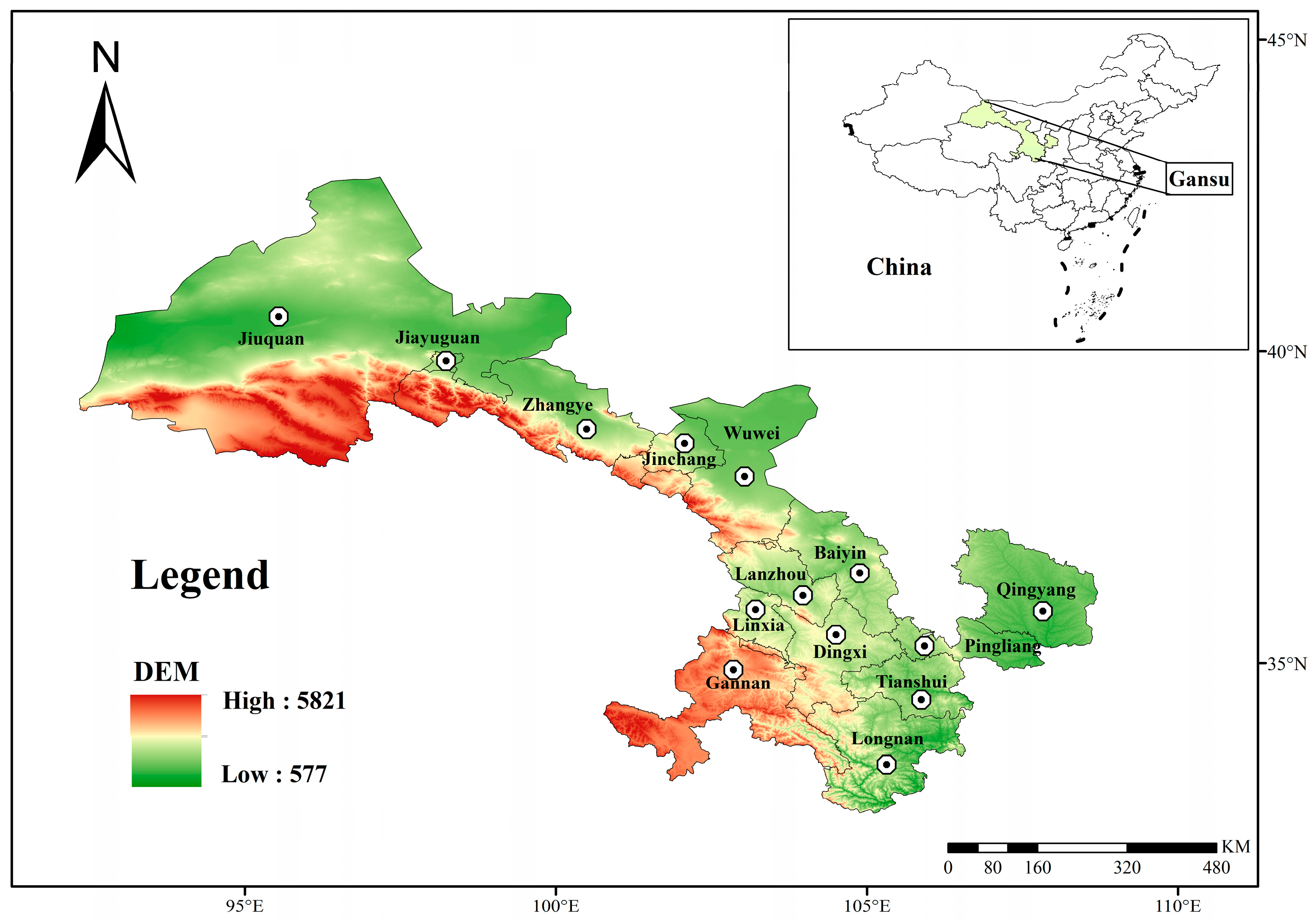

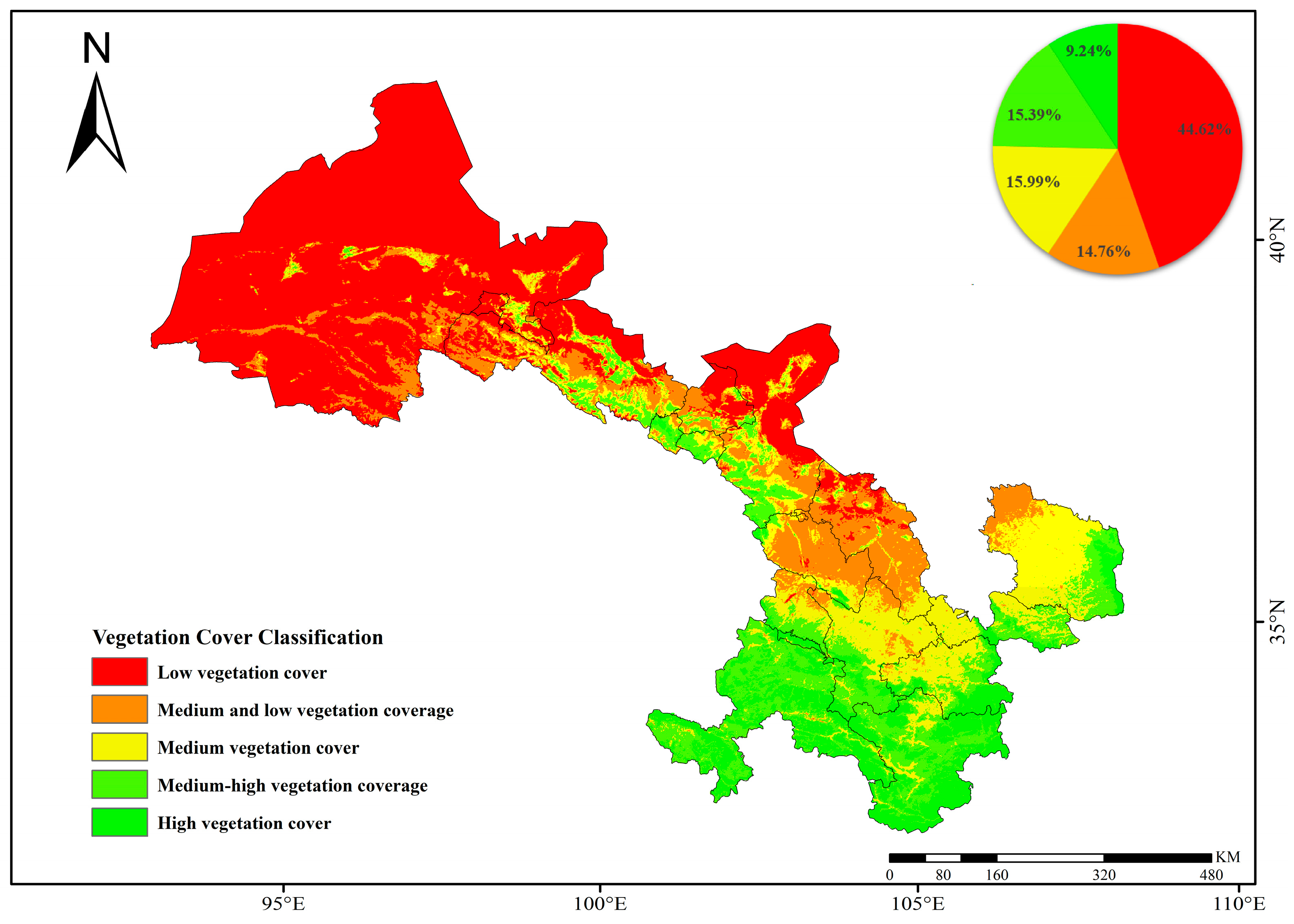
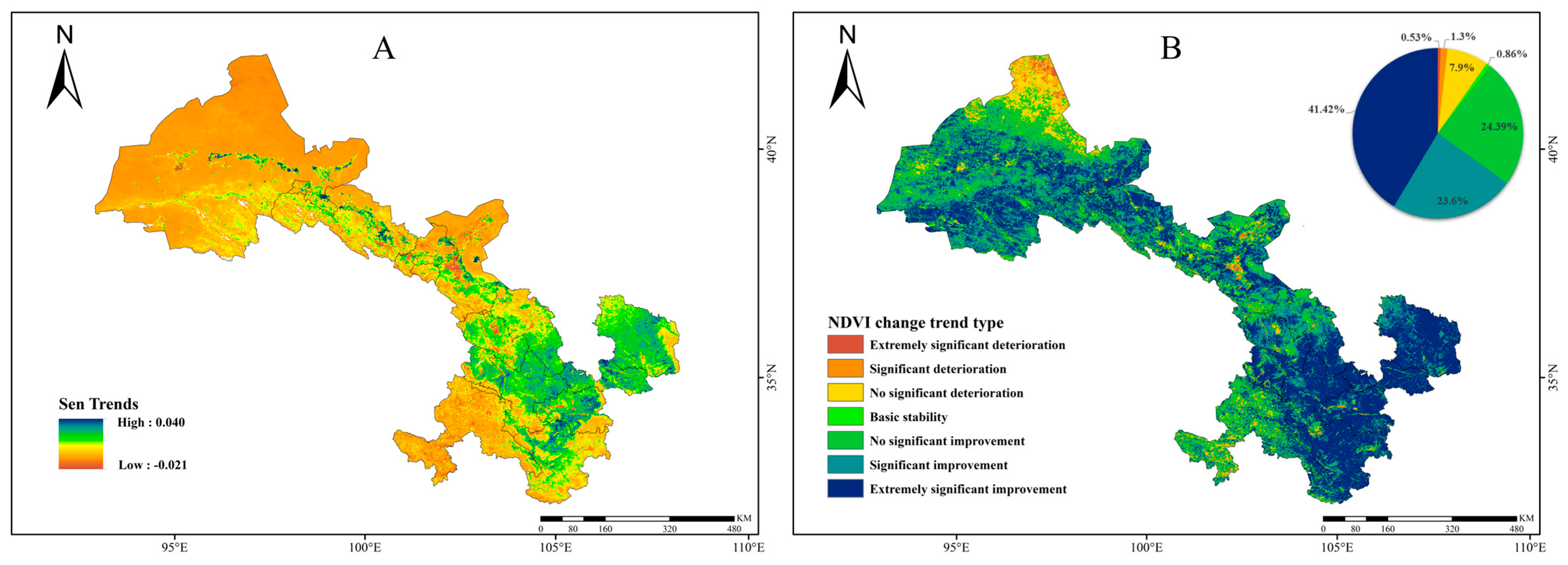


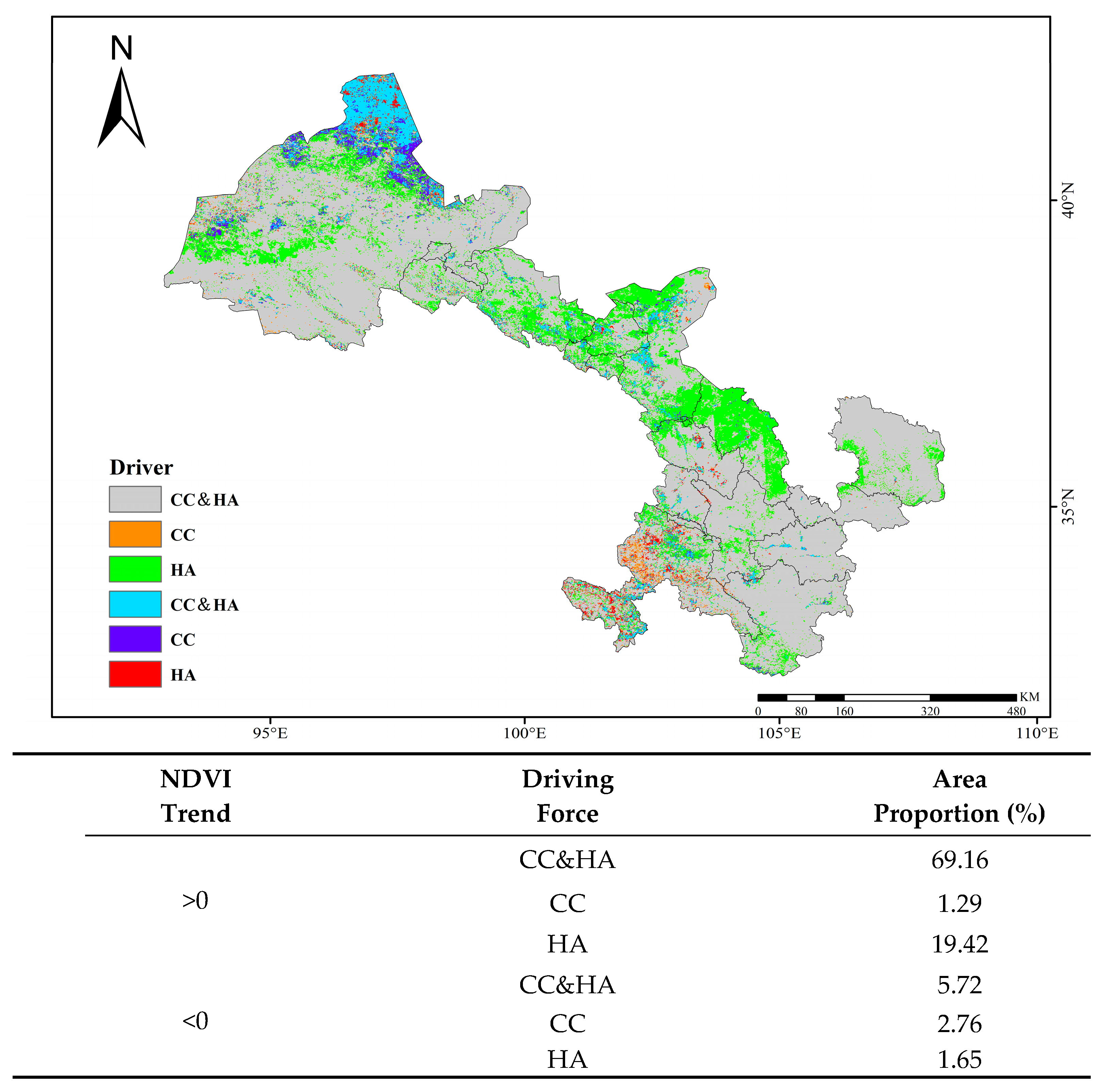
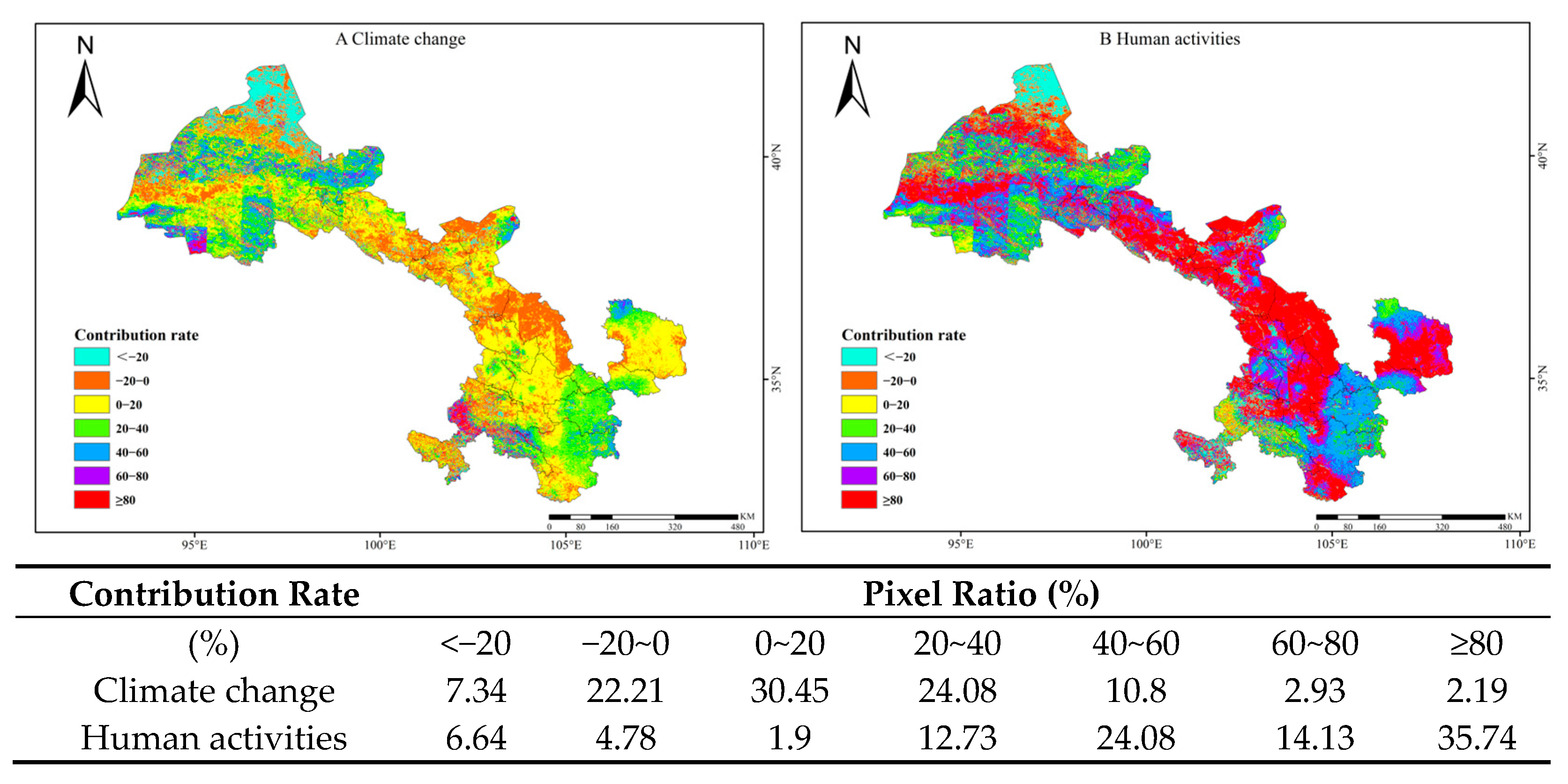
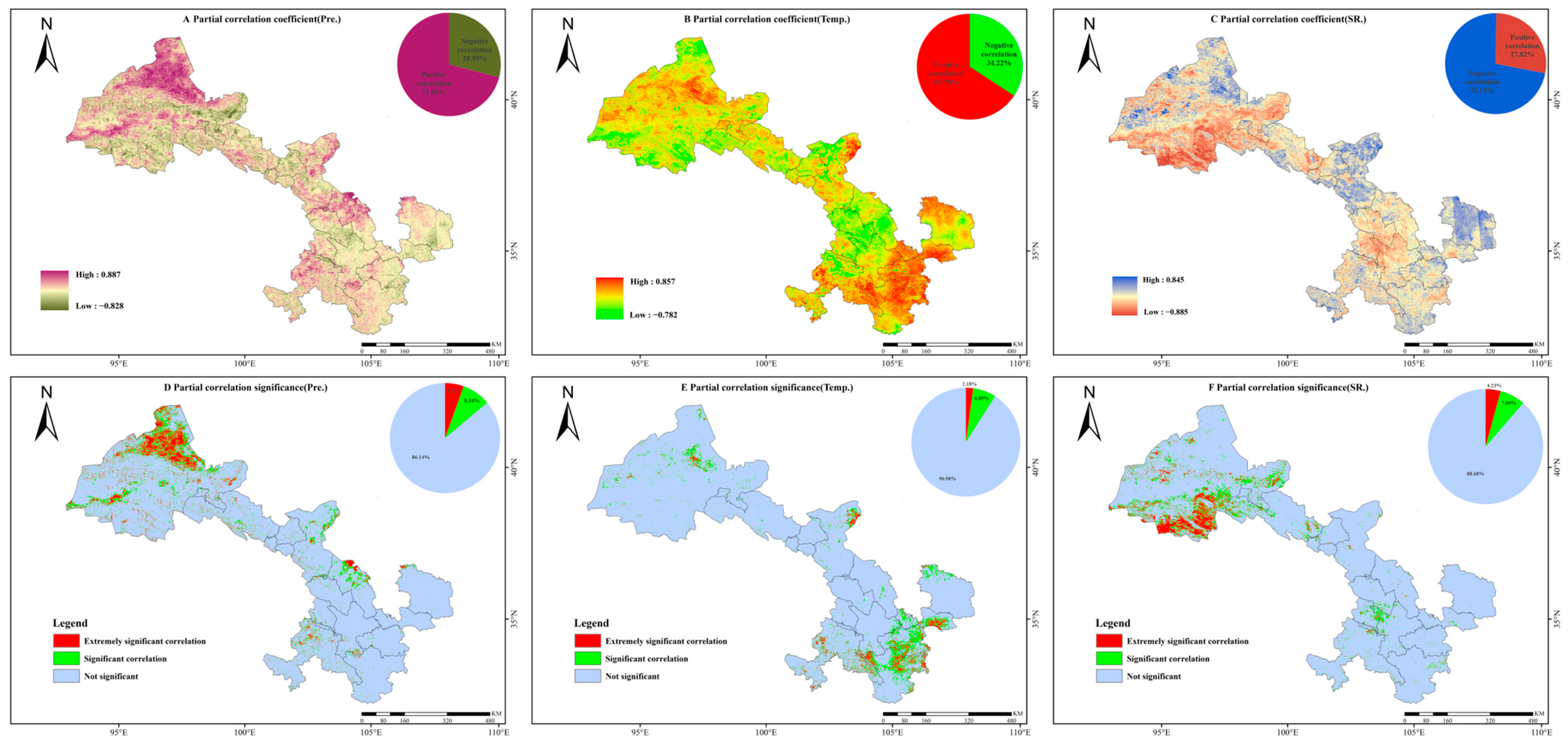
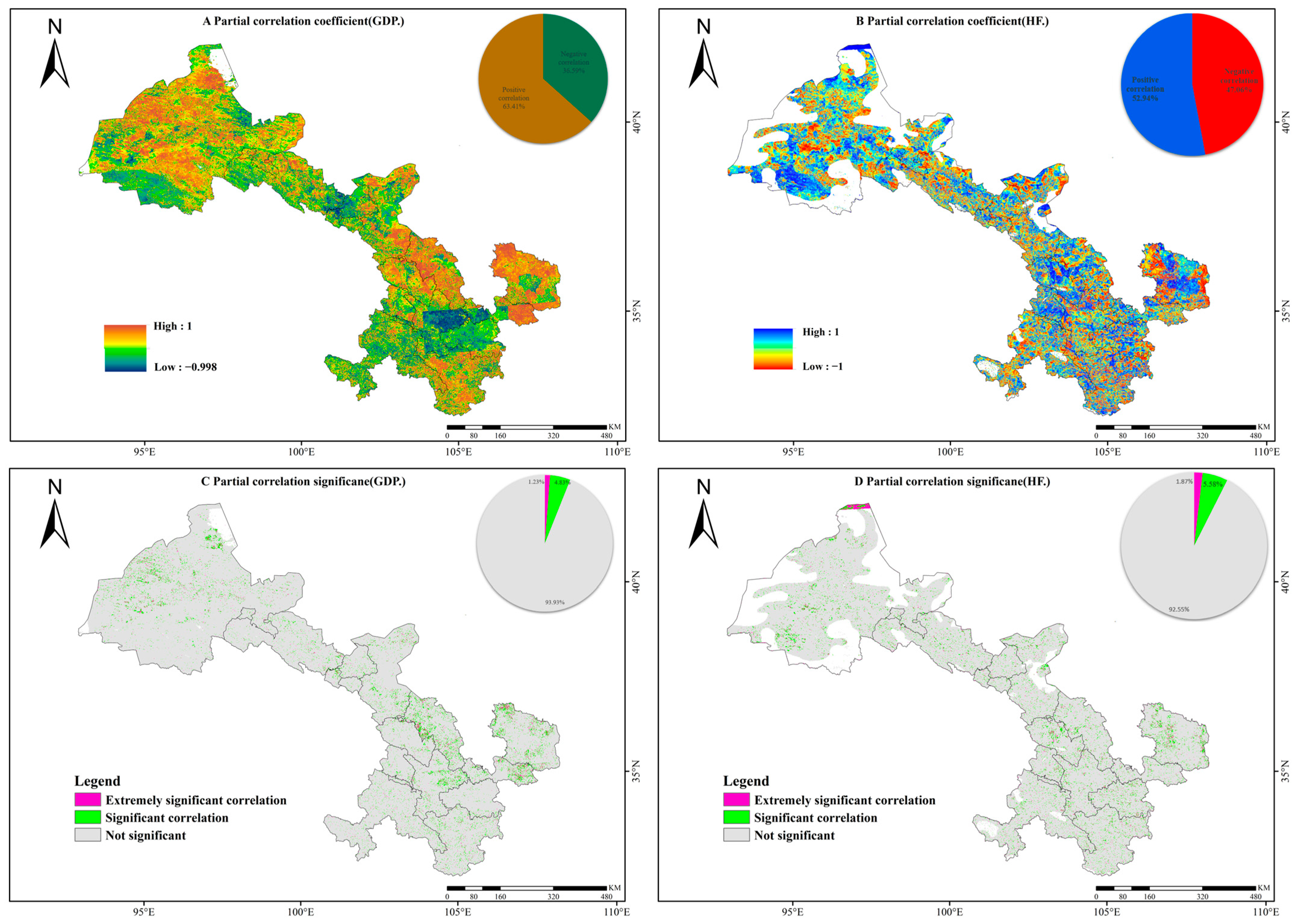

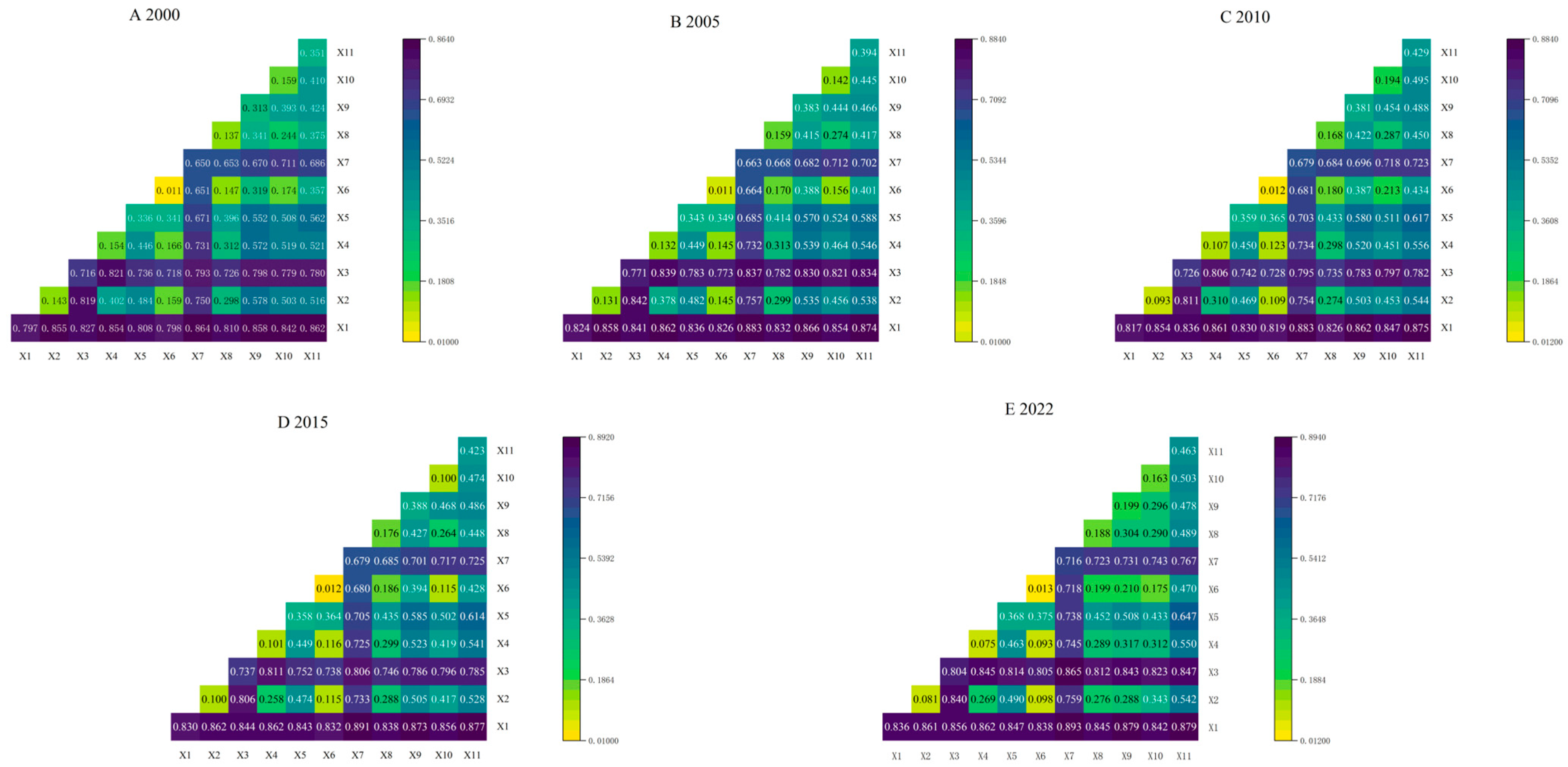
| Data Type | Factor | Data Content | Year | Resolution | Data Source |
|---|---|---|---|---|---|
| Remote sensing data | Y | MODIS13 A3 NDVI | 2000–2022 | 1 KM | https://ladsweb.modaps.eosdis.nasa.gov/search/ (accessed on 18 March 2025) |
| Climate data | X1 | Annual total precipitation | 2000–2022 | 1 KM | https://data.tpdc.ac.cn/ |
| X2 | Annual average temperature | 2000–2022 | 1 KM | ||
| X3 | Annual average solar radiation | 2000–2022 | 1 KM | https://power.larc.nasa.gov/ | |
| Terrain data | X4 | Altitude | 2022 | 1 KM | https://www.gscloud.cn/ |
| X5 | Slope | 2022 | 1 KM | ||
| X6 | Slope direction | 2022 | 1 KM | ||
| Land cover data | X7 | Land use type | 2000–2022 | 1 KM | https://doi.org/10.5281/zenodo.15853565 (accessed on 20 March 2025) |
| X8 | River density | 2000–2022 | 1 KM | https://download.geofabrik.de/ (accessed on 20 March 2025) | |
| Human factors | X9 | Population density | 2000–2022 | 1 KM | https://landscan.ornl.gov/ |
| X10 | GDP | 2000–2022 | 1 KM | https://data.tpdc.ac.cn/ | |
| X11 | Human activity footprint | 2000–2020 | 1 KM | https://www.x-mol.com/groups/li_xuecao/news/48145 (accessed on 25 March 2025) |
| β | |Z| | Trend Category |
|---|---|---|
| β > 0 | 2.58 < Z | Extremely significant improvement |
| 1.96 < Z ≤ 2.58 | Significant improvement | |
| 0 < Z ≤ 1.96 | Slightly significant improvement | |
| β = 0 | Z | No change |
| β < 0 | 0 < Z ≤ 1.96 | Micro-significant degradation |
| 1.96 < Z ≤ 2.58 | Significant degradation | |
| 2.58 < Z | Extremely significant degradation |
| Slope(NDVIobs) a | Driving Factors | The Classification Criteria of Driving Factors | Contribution Rate of Driving Factors (%) | ||
|---|---|---|---|---|---|
| Slope(NDVICC) b | Slope(NDVIHA) c | Climate change | Human activities | ||
| >0 | CC&HA | >0 | >0 | ||
| CC | >0 | <0 | 100 | 0 | |
| HA | <0 | >0 | 0 | 100 | |
| <0 | CC&HA | <0 | <0 | ||
| CC | <0 | >0 | 100 | 0 | |
| HA | >0 | <0 | 0 | 100 | |
| Interaction Type | Judgment Interval |
|---|---|
| Two-factor enhancement | |
| Nonlinear enhancement | |
| Single-factor nonlinear attenuation | |
| Nonlinear weakening | |
| Independent of each other |
| Development Direction | Future Changing Trend | Area Proportion (%) |
|---|---|---|
| Continuous degradation | Strong persistent degradation | 0.11 |
| Weak persistent degradation | 0.72 | |
| There was improvement in the past, but a regressive trend in the future | Anti-strong continuous improvement | 8.15 |
| Anti-weakness continuous improvement | 43.32 | |
| The past has deteriorated, but the future is an improving trend | Anti-weak continuous degradation | 1.74 |
| Anti-strong persistent degradation | 0.46 | |
| Continuous improvement | Weak continuous improvement | 17.62 |
| Strong and continuous improvement | 1.19 | |
| Basically stable | 26.69 |
| Year | Ranking of Interaction Influence (Top 4 Factors) |
|---|---|
| 2000 | X7 ∩ X1 > X11 ∩ X1 > X9 ∩ X1 > X2 ∩ X1 |
| 2005 | X7 ∩ X1 > X11 ∩ X1 > X9 ∩ X1 > X4 ∩ X1 |
| 2010 | X7 ∩ X1 > X11 ∩ X1 > X9 ∩ X1 > X4 ∩ X1 |
| 2015 | X7 ∩ X1 > X11 ∩ X1 > X9 ∩ X1 > X2 ∩ X1 |
| 2022 | X7 ∩ X1 > X11 ∩ X1 = X9 ∩ X1 > X7 ∩ X3 |
Disclaimer/Publisher’s Note: The statements, opinions and data contained in all publications are solely those of the individual author(s) and contributor(s) and not of MDPI and/or the editor(s). MDPI and/or the editor(s) disclaim responsibility for any injury to people or property resulting from any ideas, methods, instructions or products referred to in the content. |
© 2025 by the authors. Licensee MDPI, Basel, Switzerland. This article is an open access article distributed under the terms and conditions of the Creative Commons Attribution (CC BY) license (https://creativecommons.org/licenses/by/4.0/).
Share and Cite
Fu, J.; Zhang, X.; Zhou, X.; Liu, M.; Fan, M.; Lu, S.; Du, W.; Wang, X. Analysis of Spatial and Temporal Evolution Characteristics and Driving Forces of NDVI in Gansu Province from 2000 to 2022. Land 2025, 14, 2184. https://doi.org/10.3390/land14112184
Fu J, Zhang X, Zhou X, Liu M, Fan M, Lu S, Du W, Wang X. Analysis of Spatial and Temporal Evolution Characteristics and Driving Forces of NDVI in Gansu Province from 2000 to 2022. Land. 2025; 14(11):2184. https://doi.org/10.3390/land14112184
Chicago/Turabian StyleFu, Jianlong, Xiaowei Zhang, Xiaolei Zhou, Mingpeng Liu, Mengxi Fan, Songsong Lu, Weibo Du, and Xuhu Wang. 2025. "Analysis of Spatial and Temporal Evolution Characteristics and Driving Forces of NDVI in Gansu Province from 2000 to 2022" Land 14, no. 11: 2184. https://doi.org/10.3390/land14112184
APA StyleFu, J., Zhang, X., Zhou, X., Liu, M., Fan, M., Lu, S., Du, W., & Wang, X. (2025). Analysis of Spatial and Temporal Evolution Characteristics and Driving Forces of NDVI in Gansu Province from 2000 to 2022. Land, 14(11), 2184. https://doi.org/10.3390/land14112184






